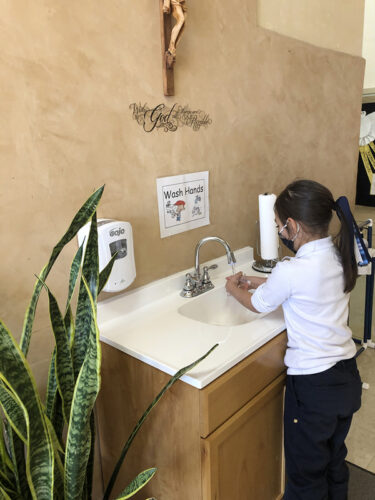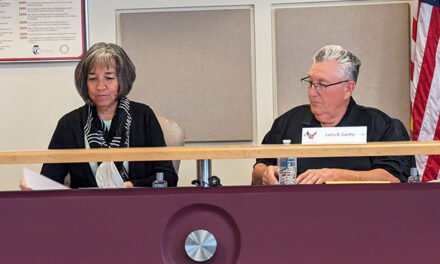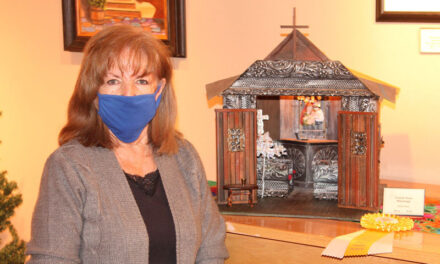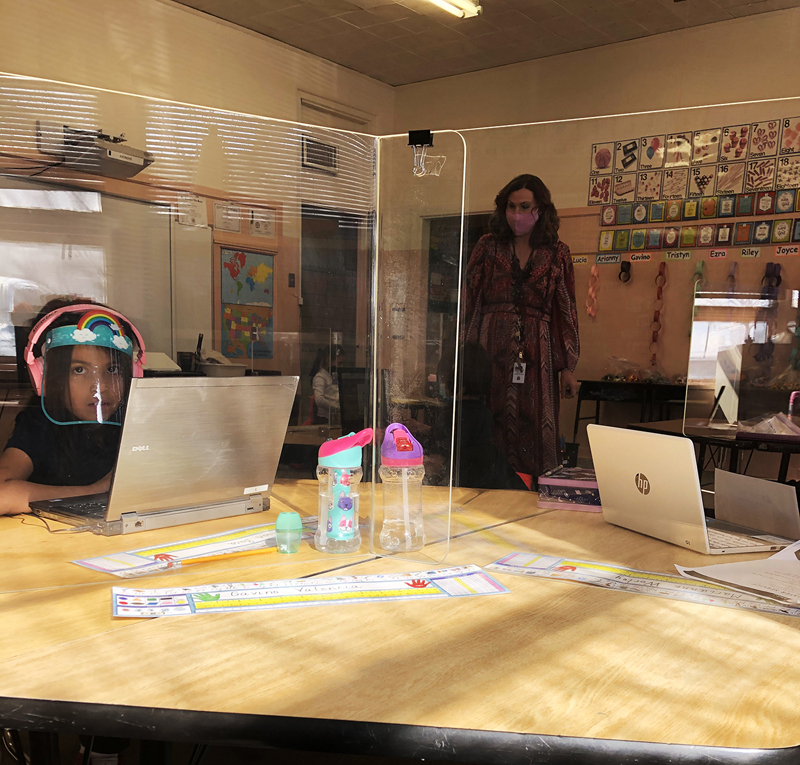
Submitted photo
Students and teachers at St. Mary’s Catholic School in Belen are required to wear masks or face shields while in the building. Plexiglass barriers are also used at student desks.
BELEN—“Six feet apart” has become something of a mantra at St. Mary’s Catholic School in Belen.
“Six feet apart, six feet apart. We’re always saying that,” said St. Mary’s interim principal Melanie S. Chavez with a chuckle during a recent phone interview.
When the state required schools go to remote learning at the end of last school year, St. Mary’s made the change, and during the summer, staff was “planning, planning, planning,” Chavez said for a return to hybrid in the fall.
When the nearly 150 pre-kindergarten through eighth-grade students returned to the private school in August, they were split into two cohorts — half in class in the morning and half in the afternoons.
“We did have some virtual learners in each session but students come five days a week, whether it’s in the morning or afternoon class,” she said.
Plexiglass barriers have been installed at each student’s desk and all students are required to wear a mask that fits over their nose.
“Everybody who enters the building has to wear a mask. If we feel a student is wearing a mask that is too big, we give them a child-sized mask,” Chavez said. “With the CARES Act money, we purchased PPE. We also do temperature checks of everyone coming in. We try to keep a handle on everything.”
A major change the school made was in the building’s central hallway. Chavez said they removed the water fountains and installed hand-washing stations all the way down the hall.
“The teachers assign their students to a station,” she said. “We have touchless hand sanitizer dispensers outside of every classroom.”
The entire school has been divided into cohorts and have specific areas they have to stick to.
“For instance, middle school students only use a specific set of doors to enter and exit the building. They only use specific bathrooms or washing stations,” Chavez said. “Even on the playground, only three classes are allowed at a time and there’s no intermingling.”
Because the school’s lunchroom is too small to allow for the 6-foot spacing, students eat in the nearby Our Lady of Belen Catholic Church’s parish hall, which allows for two students per table sitting 6-feet apart. Chavez said they added a third lunch period to have fewer students in the lunchroom.
“We have marked the school completely in and out to remind students to remain 6-feet apart. Visuals are so important for kids,” the interim principal said. “We also took any extra furniture out of the classrooms. We have even hired an extra person who’s whole job is to go around and clean high-touch areas, like doorknobs, push plates, the wash stations.”
The school also uses an electrostatic sprayer to clean the building weekly on Fridays.
Keeping students in cohorts and tracking where they enter and exit and which facilities they use allows for better response if someone tests positive for COVID-19.
“If we need to quarantine, it would only be one class,” Chavez said. “We limit the number of people into the school, which is why we’re doing this interview by phone. Even with parents, if they come early to pick up a student, we walk the student out and bring the sign out sheet to them. Less people, less contact.”
There have been some positive cases of COVID-19 among teachers at the school, but they weren’t contracted there, Chavez said.
“We had them teach virtually if they could while quarantined. We’ve not had any outbreaks,” she said. “We will keep maintaining the constant cleaning. We have gone through buckets of wipes but it’s worth it because the students are here.
“This has taken a lot of planning and we keep adding as we go and learn. We’ve had a real good year; we’ve seen a decline in all sicknesses.
“The kids are flourishing. The kids and staff are happy and that’s all we can ask for at the end of the day. We hope and pray public schools can be safe and successful as well.”
Canon Christian Academy
Canon Christian Academy in Belen also made the change to full remote at the end of last year, but teachers told Headmaster Shaun Gibson they only managed to cover 70 percent of the expected material.
“So looking at this year, there’s no way we couldn’t open,” Gibson said.
Also a factor is the annual tuition of $13,000 per student to attend the private school.
“Parents are paying for this. If we’re not open, why would they do that? Last year, we did have some parents pull their kids out and I can’t blame them,” he said.
After looking at the CDC guidance, which Gibson called “well intentioned but obviously developed by people who don’t work with children,” the headmaster felt the school could take enough precautions to open this year with full, in-person learning.
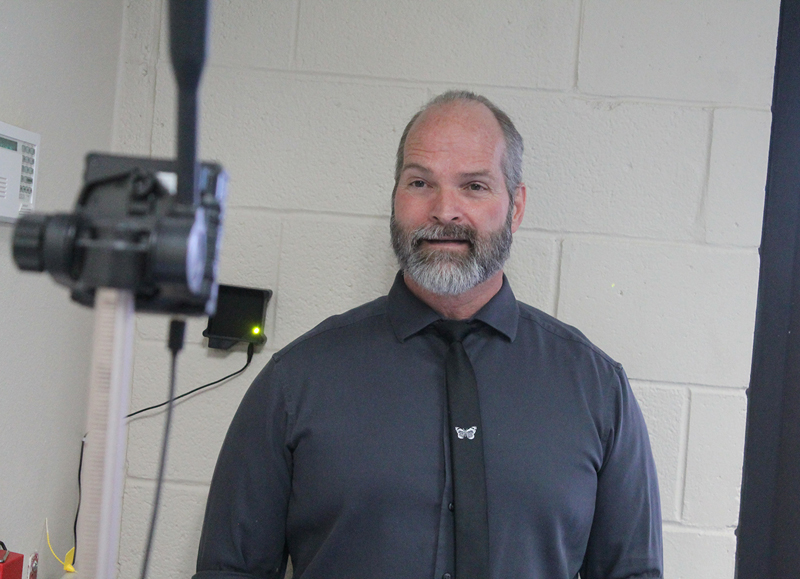
Julia M. Dendinger | News-Bulletin photo
Canon Christian Academy Headmaster Shaun Gibson demonstrates the thermal scanner that takes the temperature of students and staff as they enter building as part of the private school’s COVID-19 precautions.
“We looked at what kind of interventions can we take that would be actually successful and productive,” he said.
The school already had a hydrogen peroxide fogger, which has been used in years past to sterilize classrooms and other areas after an infectious outbreak, such as pink eye. Two additional foggers were purchased and are used daily and weekly to sterilize the building.
Because it’s a fog it touches all surfaces, including areas that might not get wiped down during a typical sanitizing, Gibson said.
“Look at my desk. It’s got so much junk on it; how would you sanitize everything? Are you going to spray the papers?” Gibson said, gesturing to piles of paperwork and knick knacks. “The fog is going to permeate the room and all the surfaces.”
High-traffic areas, such as bathrooms and the cafeteria, are sterilized daily and the entire 70,000-square-foot facility is fogged weekly.
Additionally, antimicrobial impregnated plastic film was put on door push bars, doorknobs and other high-touch areas, Gibson said, and hands-free hand sanitizer dispensers were installed in every classroom.
“We felt with those things we were going to very much improve the overall sanitation of our facility,” the headmaster said.
With about 189 kindergarten through 12th grade students at Canon, the size of the building played to the school’s advantage in terms of maintaining 6-feet of distance, Gibson said.
“We’ve got a small student population so we were really always well within any of the guidelines for occupation,” he said. “We already kind of rattle around in this place, so that wasn’t an issue.”
In regards to masks, after reading what he said were conflicting reports about the benefits of mask use on small children, Gibson said he ultimately decided to let parents make that decision. Teachers and staff aren’t required to wear masks, but teachers wear clear-plastic face shields so their faces can be seen during instruction.
Gibson describes this school year as “absolutely spectacular. I won’t say it’s our healthiest, but it’s probably one of the healthiest.”
The school has seen the biggest impact of COVID-19 in administrative and staff quarantines.
“It’s been brutal and, I believe, not based on science,” he said.
“We have some teachers who contracted (COVID-19) but hallelujah, it was over Thanksgiving and Christmas. They missed one or two days,” he said. “We kind of had a wave go through around Thanksgiving and another wave during the Christmas break.
“We were really blessed because we don’t have a surplus of staff and not a huge substitute pool.”
The headmaster said there was one student who lost their sense of taste and smell and quarantined the required amount of time, but never displayed any other symptoms of COVID-19.
Gibson said for the most part, teachers at Canon haven’t expressed much interest in getting the COVID-19 vaccine and he has no intention to make vaccination a policy issue at the school.
“I think most people here want nothing to do with a vaccine,” he said. “I think we may have one or two (interested) because maybe a family member or something, but by and large, the general consensus right now is until it’s fully FDA approved, being that it’s new technology, an mRNA (vaccine), they don’t want it.”
According to the CDC website, messenger RNA vaccines are some of the first COVID-19 vaccines authorized for use in the United States.
The vaccines do not contain a live virus and do not carry a risk of causing disease in the vaccinated person. They also never enter the nucleus of the cell and do not affect or interact with a person’s DNA.
Researchers have been studying mRNA vaccines since the late 1980s. Early stage clinical trials using mRNA vaccines have been carried out for influenza, Zika, rabies and cytomegalovirus.
Julia M. Dendinger began working at the VCNB in 2006. She covers Valencia County government, Belen Consolidated Schools and the village of Bosque Farms. She is a member of the Society of Professional Journalists Rio Grande chapter’s board of directors.
